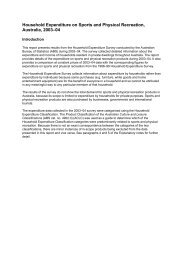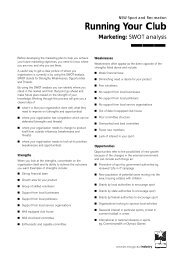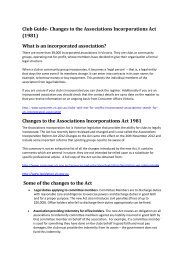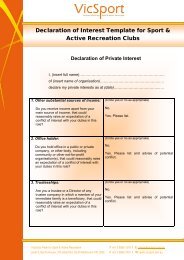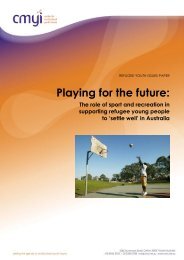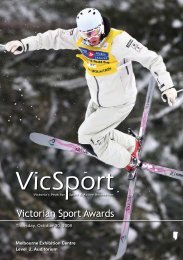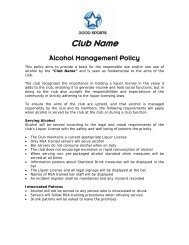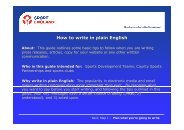School Playing Fields: Planning and Design Guidance - VicSport
School Playing Fields: Planning and Design Guidance - VicSport
School Playing Fields: Planning and Design Guidance - VicSport
Create successful ePaper yourself
Turn your PDF publications into a flip-book with our unique Google optimized e-Paper software.
Macadam surfacesMacadam surfaces may take the form of denseor porous macadam. Whilst the former mayprovide a more durable surface <strong>and</strong> is typicallylaid on school playgrounds, its inability to drain isa major constraint on sports use. For this reasonporous macadam is considered more suitable<strong>and</strong> can be played on in most weather conditionsyear round.Porous macadam courts may be colour coatedto improve aesthetics <strong>and</strong> the playing environment.This is achieved by either using pigmentedmaterials to form the macadam or by painting theun-pigmented surface after installation. Althoughthe cost of pigmented macadam may be initiallyhigher, the increased durability of the colour maymake it more suitable for areas of high use.Polymeric surfacesPolymeric surfaces have a degree of inherentshock absorption, which may be varied byincreasing the thickness of the surfacing layeror altering the composition of the polymericmaterials. To provide the high degree of slipresistance required by sports such as tennis <strong>and</strong>netball a specially modified final coating can beapplied, although the use of this surface for ballcontact sports will cause a rapid reduction in itsslip resistance. For this reason, combining sportssuch as five-a-side football <strong>and</strong> netball is notrecommended.Thicker forms of the surface may be specifiedwhere the intended sports include five-a-sidefootball or athletics training. This type ofpolymeric surface is also capable of takinga running shoe spike.Artificial grass surfacesAs explained in the section on SGPs, there aremany different types of synthetic turf constructionwith a range of properties <strong>and</strong> advantages <strong>and</strong>disadvantages. Variables include the polymerused for the fibre yarn, the cross-sectional areaof the individual ribbons of fibre, the method ofcarpet manufacture, the pile height <strong>and</strong> piledensity. Two principal designs are offered forMUGAs – those with a vertical pile of tufted,woven or knitted construction that is supportedwith a s<strong>and</strong> filling or dressing <strong>and</strong> those with aninterlocking pile of needle-punch constructionthat are also filled or dressed with s<strong>and</strong>.The majority of synthetic turf pitches are surfacedwith tufted s<strong>and</strong> filled carpets. Experience hasshown this form of carpet to have good durability<strong>and</strong> performance for MUGAs. S<strong>and</strong>-dressedcarpets are a more recent innovation. They havea shorter, denser pile than the st<strong>and</strong>ard filledsystems with a reduced quantity of s<strong>and</strong> fill <strong>and</strong>are primarily suited for MUGAs where hockey isthe primary sport. Needle-punched carpets offerbenefits of increased s<strong>and</strong> stability within the pile<strong>and</strong> higher drainage characteristics.Synthetic grass surfaces often have a shockpadwhich is a resilient layer introduced between thebase <strong>and</strong> the playing surface. This is used toprovide a degree of comfort to players <strong>and</strong> tocreate the required playing characteristics forspecific sports. The most common componentsare rubber crumb/shred mixed with a resin binderalthough there are other types which have beendeveloped to suit particular performancecharacteristics. The type <strong>and</strong> thickness of shockpad chosen will be dictated by the priority sport.RefurbishmentThe requirements for ongoing major expenditurewill depend upon the type of surface provided.Macadam facilities should have a life span inexcess of 25 years but artificial grass <strong>and</strong>polymeric surfaces will need to be rejuvenated<strong>and</strong> refurbished at regular intervals.Polymeric courts also have periodic maintenancerequirements. A newly laid surface should givefirm foothold <strong>and</strong> good medium-paced ballspeed. As the surface is used over the years,however, it will become smoother <strong>and</strong> morepolished <strong>and</strong> this may result in increased ballspeed <strong>and</strong> some impairment of the footholdwhen the surface is damp. When this happensit will be time for the surface to be re-coated/retextured. Re-texturing will normally need to becarried out every four years <strong>and</strong> can only usuallybe carried out on three occasions before thesurface water infiltration rates are reduced belowan acceptable st<strong>and</strong>ard. Once this stage hasbeen reached, around year 16, the old surfacemust be drilled <strong>and</strong> a new surface laid.Cricket squaresThe prime requirement for cricket is a suitablecricket table which, for economy of l<strong>and</strong> use,is usually combined with winter sports pitches.Grass hockey pitches have historically tendedto provide the best outfield for cricket given thebetter quality of grass <strong>and</strong> truer surface usuallyto be found in these facilities. The switch toSGPs for hockey, however, means grass hockeypitches are becoming less common. Footballpitches can also provide suitable outfields forcricket but rugby pitches, because of theconsiderable disturbance to the pitch surfacewhich can result from normal play, cannot usuallyprovide a sufficiently fast, true <strong>and</strong> safe surface.Formal cricket wickets are constructed usingtechniques which differ greatly from most othernatural grass facilities. The performance aim ofa cricket wicket is for a regular surface whichwill have the capability to allow a ball to reboundfrom its surface without absorbing too muchof the downward force applied by the bowler.Consequently, the surface must allow for aregular bounce <strong>and</strong> should be true to line <strong>and</strong>level to avoid dangerous conditions. Providingthe desired playing characteristics <strong>and</strong> a naturalgrass surface which is capable of draining<strong>and</strong> sustaining grass growth is very difficultto achieve.A new, modern wicket would ideally beconstructed as follows:• excavating the area of the wicket (generally825 square metres or thereabouts);• creating a construction profile which wouldinclude a drainage system below a gravel raft;• placing a depth of free draining s<strong>and</strong> loam overthe gravel raft; <strong>and</strong> finally,• adding a depth of carefully selected clay loamwhich would be consolidated <strong>and</strong> seeded.<strong>School</strong> <strong>Playing</strong> <strong>Fields</strong> 48<strong>School</strong> <strong>Playing</strong> <strong>Fields</strong> 49



